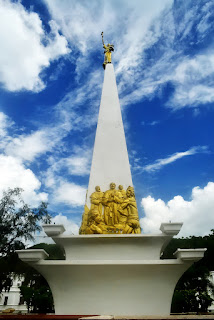Samar...
Prior to the coming of the Spaniards in 1596, Samar Island was called in different names (Samal, Ibabao/Cibabao, Tandaya, etc.). Legend says that when the Spaniards arrived in Homonhon Island, they met a wounded man and asked the name of the place, he replied “samad” which implies of what had happened to him for he didn’t understand Spanish. So, the word “samad” was adopted with an alteration in the last letter (from d to r). The name Samar was derived from the local dialect “Samad”, meaning wound or cut, which aptly describes the rough physical features of the island that is rugged and deeply dissected by streams or a multitude of rivers dissect the island in various directions like crease-crossing wounds.
In the early days of Spanish occupation, Samar and Leyte islands were under the jurisdiction of Cebu. In 1735, Samar and Leyte were separated from Cebu and declared into one province with Carigara, Leyte as the capital. Consequently, during the Spanish-American colonial period, Samar was separated from Leyte and declared as a province in 1768 with Catbalogan as the provincial capital.
June 19, 1965, RA 4221 was passed by Congress dividing Samar Island into three (3) provinces: Northern Samar with Catarman as capital, Eastern Samar with Borongan as capital, and Western Samar with Catbalogan as capital. A subsequent legislation passed on June 21, 1969 (RA 5650) changed the title “Western Samar” to simply Samar.
Catbalogan
It is said that Catbalogan was originally known as KATBALAUGAN or KABALAUGAN, after a shrub called “balaug” that used to thrive along its seashore and the sandy banks at the mouth of the Antiao River. Before the coming of the Spaniards, fishermen from the Island of Buad (now Zumarraga), whose custom was to set out fish at the start of the dark nights of the “Katdulom” phase of the month’s cycle and return only when they ended, would run their boats up this balaug – lined shore of the Samar mainland to rinse their fishing nets (pagsawsaw han pocot) in the Antiao River and, having hung the nets out to dry on the shrubs, take a rest. It was just a place to lie down but a good one, for later those fishermen permanently settled with their families in the Kabalaugan: Balaug Land.
In short, before the once uninhabited place metamorphosed into a small
settlement, then to a pueblo and today a booming town, it started with a simple
and humble beginning purely influenced and dictated by Mother Nature – it’s
God’s given geography. The uninhabited place was a coastal plain and on its
interior side was plain to moderately rolling and steep. And it is embraced or
surrounded by the Marine Rich Maqueda Bay (the Fish Basket of the Region) and
it is the place where the fresh water of the huge Antiao River meets the calm
seawater of the Maqueda Bay.
The place became a safe haven for seafarers, fishermen and sailors for a
temporary mooring and sanctuary to take a break from long sea journey,
katdulom, bad weather and above all a refuge from marauding Moro Pirates.
During that period, the place was teeming with moored small and big sailboats
when the northwest and southwest monsoons blew during the month of July, August and September – “Habagat,” where the weather is almost unfriendly to small fishermen.
During the early days of Spanish occupation of the Philippines, Samar
came under the jurisdiction of Cebu. Later, it was declared a separate province
but, in 1735, Samar and Leyte were united into one province with Carigara, in
Leyte, as the Capital. The union did not prove satisfactory, however, so in 1768,
Samar became province from Leyte. Since then, Samar emerged as an independent
political unit with Catbalogan as the capital.
Becoming a City...
Catbalogan City attained its cityhood on March 15, 2007 (along with 15
other cities in the Philippines) through the sponsorship of Senator Alfredo S.
Lim and by the virtue of Republic Act No. 9391 despite the opposition by the
League of Cities of the Philippines, particularly Catbalogan City’s neighbor,
Calbayog City. On June 16, 2007, Catbaloganons ratified the change by a Comelec
plebiscite with over 92% of “YES” votes to make Catbalogan a component city
known as the City of Catbalogan.
But the League of Cities of the Philippines filed a petition to Supreme
Court of the Philippines to declare the cityhood law (RA 9391)
unconstitutional. In a very close 6-5 vote, RA 9391 which allowed the town to
acquire its city status, was declared unconstitutional. Thus, Catbalogan
temporarily lost its cityhood.
On December 10, 2008, Catbalogan City and the other 15 cities affected
filed a motion for reconsideration with the Supreme Court. More than a year
later, on December 22, 2009, acting on said appeal, the Court reversed its earlier
ruling. As such, the cityhood status of Catbalogan is effectively restored as
well as the other 15 cities.
Delicacies...
 |
| Rice Puto |
 |
| Tamalos |
 |
| Banana Fritter |
 |
| Baduya |
Catbalogan City is the
capital of Samar Province. It is Samar's main
commercial, trading, educational, political and financial center. It is also an
important and major seaport serving inter-island vessels. Catbalogan City's
central geographical location in Eastern Visayas makes it ideal as the gateway
to the region's three Samar provinces.
Catbalogan is a new city
featuring high-potential eco-tourism that is almost untouched and unexplored. Its eco-tourism edge earned
its role in the growth of tourism in the Philippines. These tourist attractions
are now available to everyone who wants to visit the province.
 |
| Bangon Falls 2 |
 |
| "Campo" Historical Landmark |
 |
| Catbalogan's Oldest Tree |
 |
| The Obelisk |
 |
| Pieta Park |
 |
| Darahuway Dako and Guti Island |
 |
| Bito Cave |
 |
| Payao Beach |
 |
| Cal-apog Beach Resort |


No comments:
Post a Comment